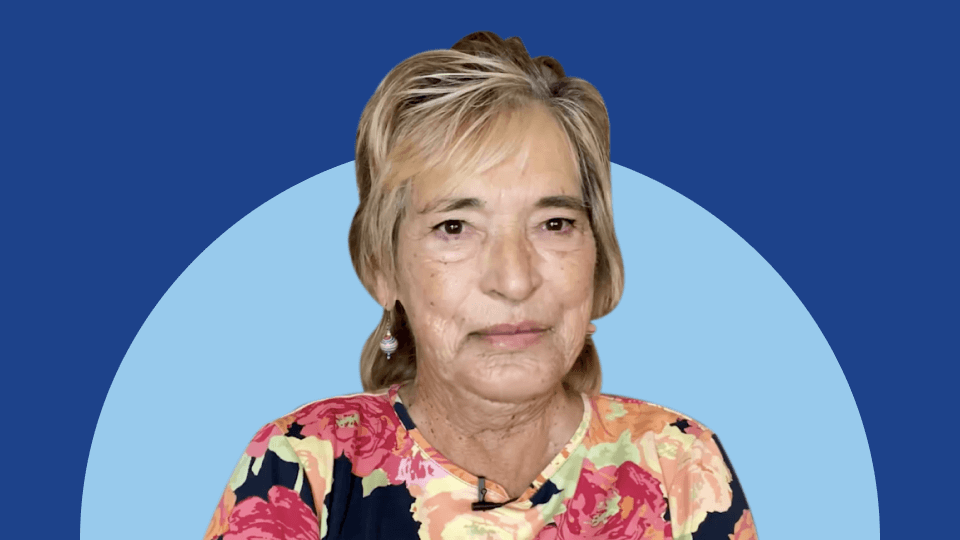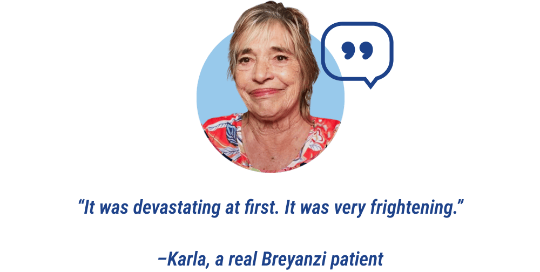
KARLA HOPED FOR SUCCESS WITH BREYANZI® AFTER HER FIRST TREATMENT FAILED

KARLA HOPED FOR SUCCESS WITH BREYANZI® AFTER HER FIRST TREATMENT FAILED
Home > How Breyanzi Can Help > Hear From Breyanzi Patients > Karla
Karla was part of the Breyanzi clinical trial, which led to the FDA approval of Breyanzi.

From water skiing to playing softball and getting into golf, Karla was always active.
However, as Karla describes it, she had no idea she was sick—not until some pain in her back became a medical emergency that involved taking a helicopter to a major medical center.
The back pain was caused by a tumor on her spine, and it needed to be surgically removed. During surgery, the doctor took a sample of her tissues to see what else was going on.
Karla had stage 4 large B-cell lymphoma. She was stunned.
Other than the intense back pain, Karla had no symptoms that would suggest cancer, such as swollen lymph glands and sweats. Karla took the time to learn that lymphoma is a cancer of the blood, meaning it can travel throughout her whole body.
After the spinal surgery, Karla was unable to walk and was in a wheelchair for a while. It would be a month before treatment for the cancer could start, so that she had time to recover.
Following spinal surgery, Karla was able to start focusing on treatment for the lymphoma. She had chemotherapy, followed by radiation.
After treatment, Karla was in remission. “I was confident that I was never going to go through this again because I’ve never been sick in my life.” Unfortunately, less than a year later, the cancer came back. Karla was devastated.
When the cancer came back, Karla was referred to a bone marrow transplant specialist.
One of the first options they talked about was stem cell transplant. The idea of asking a friend or family member for their cells was not something that Karla could do. That’s when the doctor told Karla about Breyanzi CAR T cell therapy—a treatment that uses her own cells to fight the cancer.
Because Karla had already received 1 previous line of treatment that didn’t work or stopped working, Karla was a candidate to receive Breyanzi as a second line of treatment. Karla talked about treatment options with her oncologist and decided to join a Breyanzi clinical trial.
Since Karla had never heard of CAR T cell therapy before, she went to the doctor with the questions she had. Her doctor’s answers helped explain every step, making very clear what was going to happen. This helped Karla to imagine what was happening inside her body.
“She explained that they would remove the blood cells. These cells would then be, after a process, returned to me as Breyanzi. She said to think of them as little soldiers that are there to help kill the cancer cells. The cells that were altered would recognize cancer cells, as well as some healthy cells, and attack them.”
Karla was curious: CAR T cell therapy meant that she did not have to ask someone for their cells; she would have her own cells back.
They also talked about the possible side effects that are life-threatening or fatal, including cytokine release syndrome and neurologic toxicity, as well as other common side effects, including fever, low white or red blood cells, severe diarrhea, or severe nausea.
See additional Breyanzi Important Safety Information.
While Karla’s daughter thought that choosing CAR T cell therapy was a “no-brainer,” Karla was on the cusp. She had questions. She wasn’t sure.
After careful consideration, Karla and her doctor felt Breyanzi was the right choice for her. Once the decision was made, things moved forward quickly.
Karla was looking forward to what she hoped would be her second, and last, line of treatment.
“Up to this point, you’re getting ready for it. You’re preparing your body to receive treatment. And, oh my gosh, that day of getting those cells injected was when it got really interesting because you think, okay, this is it. It was a very exciting time.”
Karla stayed in the hospital after treatment to be monitored in case she experienced side effects. Her healthcare team took her temperature and monitored her bloodwork closely. Side effects with Breyanzi treatment will vary from patient to patient. Breyanzi can cause side effects that may be life-threatening and can lead to death, such as cytokine release syndrome and neurologic toxicities. Because of the risk of cytokine release syndrome, neurologic toxicity, and other side effects, patients like Karla must remain at, or close to, where they received treatment for at least 4 weeks after the infusion for side-effect monitoring.
For Karla, one of the hardest parts of treatment was to be cared for by others. However, she was so thankful for the support, especially what she received not long after her infusion.
“Through this, I learned that when people ask if they can do something for you, you accept their help with thanks and gratitude because I know I would do the same thing for someone else.”
When Karla got her first PET scan after being treated with Breyanzi, she was excited to hear the scans were clear.
Karla says she’s a homebody who loves her home, yard, and doing things with her family. For her, it’s about doing the little things: being with her family and watching them grow and thrive.
Although results will vary from person to person, Karla urges others to talk to their doctors about Breyanzi to see if this treatment approach may be right for them.







